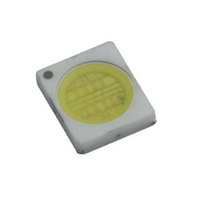NZ10150-T1 Seoul Semiconductor Inc, NZ10150-T1 Datasheet - Page 15

NZ10150-T1
Manufacturer Part Number
NZ10150-T1
Description
LED WARM WHITE 3000K DIFF SMD
Manufacturer
Seoul Semiconductor Inc
Series
Z Power Z1r
Specifications of NZ10150-T1
Color
White, Warm
Current - Test
400mA
Luminous Flux @ Current - Test
75lm
Current - Max
450mA
Lumens @ Current - Max
83lm
Lumens/watt @ Current - Test
45lm/W
Voltage - Forward (vf) Typ
4.2V
Wavelength
3000K
Lens Style/size
Round, 4.6mm
Viewing Angle
120°
Mounting Type
Surface Mount
Package / Case
6.00mm L x 5.00mm W x 1.20mm H
For Use With
876-1003 - LM3406 LED DRIVER EVAL BOARD
Lead Free Status / RoHS Status
Lead free / RoHS Compliant
Other names
897-1015-2
(1) During processing, mechanical stress on the surface should be minimized as much as
possible. Sharp objects of all types should not be used to pierce the sealing compound.
(2) In general, LEDs should only be handled from the side. By the way, this also applies
to LEDs without a silicone sealant, since the surface can also become scratched.
(3) When populating boards in SMT production, there are basically no restrictions
regarding the form of the pick and place nozzle, except that mechanical pressure on the
surface of the resin must be prevented.
This is assured by choosing a pick and place nozzle which is larger than the LED’s
reflector area.
(4) Silicone differs from materials conventionally used for the manufacturing of LEDs.
These conditions must be considered during the handling of such devices. Compared to
standard encapsulants, silicone is generally softer, and the surface is more likely to
attract dust.
As mentioned previously, the increased sensitivity to dust requires special care
during processing. In cases where a minimal level of dirt and dust particles cannot be
guaranteed, a suitable cleaning solution must be applied to the surface after the
soldering of components.
(5) SSC suggests using isopropyl alcohol for cleaning. In case other solvents are used, it
must be assured that these solvents do not dissolve the package or resin.
Ultrasonic cleaning is not recommended. Ultrasonic cleaning may cause damage to the
LED.
Handling of Silicone Resin LEDs
Document No. : SSC-QP-7-07-24 (Rev.00)
www.acriche.com
www.acriche.com
October. 2010
October. 2010
Rev. 10
Rev. 10
















